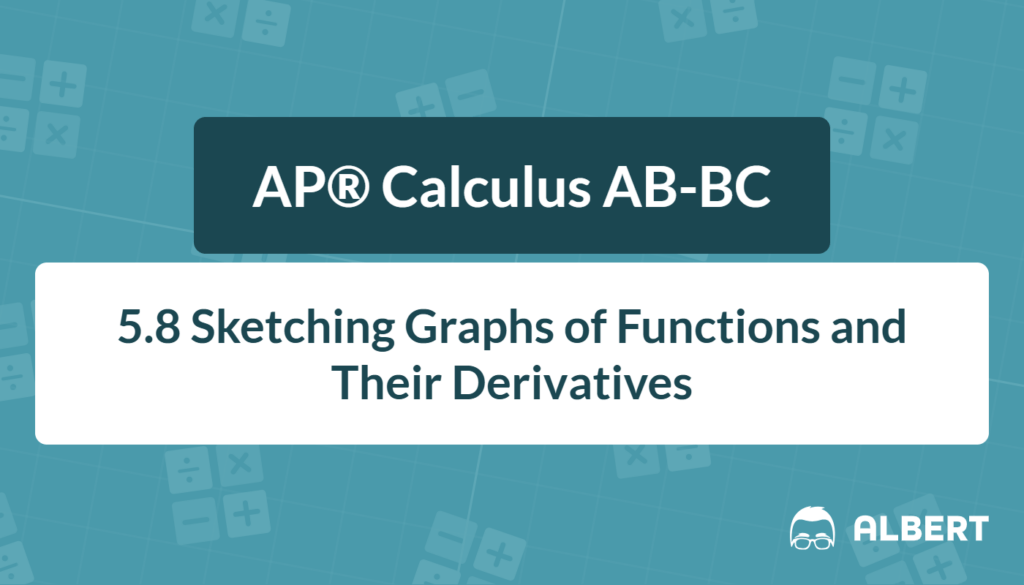Mastery of “sketch the graph of a derivative” and sketching derivative graphs can turn a tough FRQ into easy points. Therefore, every AP® Calculus student should feel comfortable with this skill. According to College Board learning objectives FUN-4.A.9 and FUN-4.A.10, students must describe how features of f appear on the graphs of f' and f''. This article explains the need-to-know facts, a clear 4-step strategy, two worked examples, and a handy reference chart.
What We Review
Foundations: What a Derivative Graph Represents
A derivative measures slope—an instantaneous rate of change.
- Positive slope means the original function rises.
- Negative slope means it falls.
- Zero slope shows a horizontal tangent.
Consequently, sketching derivative graphs turns “steepness” pictures into new curves. On the AP® exam or in the AP® curriculum, the prompt or section title may read “sketch the derivative of a graph,” “5.8 sketching graphs of derivatives,” or “how to sketch the derivative of a graph.” Regardless of wording, the task is the same: translate slope information into a graph of f'.
Key Relationships Among f, f', and f''
A. Increasing vs. Decreasing
- f increases ⇔ f' > 0.
- f decreases ⇔ f' < 0.
B. Local Maxima and Minima
Local peaks and valleys occur where f' = 0 and f' changes sign.
C. Concavity and Inflection
- f'' > 0 (or f' rising) ⇔ f is concave up.
- f'' < 0 (or f' falling) ⇔ f is concave down.
- Inflection points happen where f'' = 0 and concavity changes.
D. Quick Summary
- Slopes of f become heights of f'.
- Peaks of f drop to x-intercepts on f'.
- Steep segments on f turn into high or low points on f'.
The 4-Step Strategy for Sketching Derivative Graphs
- Mark Critical x-Values
- Identify where the slope of f looks zero or undefined.
- Classify Sign Intervals
- Decide where slopes are positive or negative; label each interval.
- Estimate Relative Steepness
- Steeper segments give larger |f'| values, setting vertical scale.
- Check Concavity Cues
- Ensure f' rises when f is concave up and falls when concave down; then draw a smooth curve.
Mini-Checklist (post-it style)
- Tangent flat → f' = 0
- Slope undefined → open circle or vertical asymptote on f'
- Rising slopes → f' > 0
- Falling slopes → f' < 0
Worked Example #1 – Smooth Curve
Prompt
The graph of f is a smooth “double-hump”: rising from left, peaking at x=-2, dipping to a valley at x=1, then rising again.
Step-by-Step Solution
- Mark critical x. Slopes appear zero at x=-2 and x=1.
- Determine sign.
- For x<-2 the graph rises, so f'>0.
- Between -2 and 1 it falls, so f'<0.
- After 1 it rises again, so f'>0.
- Estimate steepness. The hill near -2 is steeper than the valley near 1. Therefore, the positive values of f' are higher in magnitude than the negative peak.
- Draw f'.
- Plot zeros at x=-2,1.
- Sketch a larger positive hump left of -2, dip to a smaller negative value between, then rise to positive afterward.
- Concavity check. Since f is concave down on the first hump, f' should be decreasing there. The sketch confirms this, ensuring accuracy for FUN-4.A.10.
Result: a smooth “U-shaped” curve crossing the x-axis twice.
Worked Example #2 – Piecewise & Corner Points
Prompt
Consider a graph made of straight segments:
- From x=-3 to x=0, slope = 2.
- At x=0 a sharp corner occurs.
- From x=0 to x=2, slope = -1.
- From x=2 to x=4, slope = 0 (flat line).
Solution Steps
- Critical points arise at x=0 (corner) and at the endpoints where slope changes.
- Sign chart: slope 2 (positive), then -1 (negative), then 0.
- Steepness: constant, so f' will be horizontal segments at heights 2 and -1.
- At x=0 the slope jumps, hence f' has an open circle at height 2 just left of 0, another open circle at -1 just right, and no value exactly at 0.
- From x=2 to 4, slope 0 gives the x-axis segment.
Therefore, the derivative graph is three horizontal pieces: y=2, y=-1, and y=0, with a jump discontinuity at x=0.
AP® Tip: Multiple-choice items often hide such jump behavior among distractors.
Common Pitfalls & Quick Fixes
- Misreading a barely tilted segment as horizontal—zoom mentally!
- Ignoring vertical tangents or cusps; remember, f' is undefined there.
- Confusing height with slope; always look at angle, not position.
- Forgetting to match concavity: if f bends upward, f' should rise.
Quick Reference Chart
| Term | Meaning on f | Appearance on f' |
| Critical Point | f' = 0 or undefined | x-intercept or gap |
| Increasing | Rises left→right | f' > 0 |
| Decreasing | Falls left→right | f' < 0 |
| Inflection Point | Concavity changes | Local extremum of f' |
| Vertical Tangent | Infinite slope | Vertical asymptote/gap on f' |
Conclusion
Sketching derivative graphs transforms visual slopes into precise calculus insights. The 4-step strategy, supported by the examples above, aligns with FUN-4.A.9 and FUN-4.A.10. Consequently, practicing these steps builds the confidence needed to tackle any AP® question on “sketching derivative graphs.” Keep the checklist handy, avoid the common pitfalls, and success will follow.
Sharpen Your Skills for AP® Calculus AB-BC
Are you preparing for the AP® Calculus exam? We’ve got you covered! Try our review articles designed to help you confidently tackle real-world math problems. You’ll find everything you need to succeed, from quick tips to detailed strategies. Start exploring now!
- 5.7 Using the Second Derivative Test to Determine Extrema
- 5.9 Connecting a Function, Its First Derivative, and Its Second Derivative
Need help preparing for your AP® Calculus AB-BC exam?
Albert has hundreds of AP® Calculus AB-BC practice questions, free responses, and an AP® Calculus AB-BC practice test to try out.








